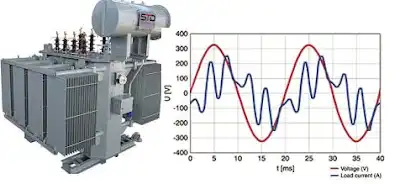What are the effects of harmonics on power transformers?
Power system experts have researched and reduced harmonic current and voltage aberrations throughout the years. Given the growing number of devices that contribute to harmonic production, such as diodes, power transistors, and rectifiers, we predict that power electronic loads will be critical components of power at all stages. This is owing to their impact on the controllability and efficacy of power loads, as seen by a rise in harmonics and power network distortions.
Transformers are important components in power systems. The measuring of iron and copper losses in single-phase transformers is important, especially for transformers that feed nonlinear loads. Power losses caused by higher harmonic distortions and abnormally high transformer temperatures can be linked to core stray magnetic losses, winding losses, and eddy currents. As a result, harmonics can have a negative impact on the power factor of capacitors when connected, hence resonance in the supply inductance must be avoided. Furthermore, in the presence of harmonics, the eddy current approximates a rise with the square of the current, and as such, eddy current is the most concerning of the sources of current losses in transformers. This entails first determining the harmonic spectrum of load currents before estimating excess losses.
The usage of nonlinear loads in power systems can frequently result in a reduction in the service life of a transformer due to the potential effect of higher heat losses. Before assessing the performance of a transformer, several parameters must be satisfied, such as knowledge of the load mix, total harmonic distortion (THD), and specifics about the content of the load current harmonics. The transformer design principles and load current harmonics are two elements that contribute to the excess heating noticed in a transformer.

Harmonics Forms
Harmonics often show as irregular current or voltage (current harmonics) or voltage (voltage harmonics) waveforms. Bridge rectifier circuits typically generate current harmonics, which impact the electrical equipment that delivers harmonic current to conductors or transformers. Third order harmonics have garnered a lot of attention in research, which has led to the creation of electrical systems that feed single phase loads and allow the neutral conductor to draw a lot of current. Components of electrical devices, on the other hand, are sensitive to voltage harmonics, which occur when current harmonics succeed in causing voltage supply sags. When a device draws current, a voltage drop is created that is necessary for the current to flow. The amount of the sag is determined by a number of parameters, including transformer impedance and wire diameter. It is commonly believed that voltage harmonics are created by current harmonics; nevertheless, the strength of voltage harmonics is determined by the’stiffness of the system’s impedance during electrical distribution’. The ordinary light bulb may be used to illustrate the link between current distortion and voltage distortion. The low-cost light bulb’s current THD may be about 75%, implying that harmonic current accounts for 75% of the total current used by the bulb. Light bulbs have little influence on other household equipment because they induce a relatively minor sag in the voltage supply to the house, despite the fact that the current taken by them contains 75% harmonics. This impact may be seen more clearly using a voltage analyzer, where the THD voltage is less than 1%.
Harmonics suppression
In general, harmonics can be reduced by selecting equipment with low THD currents, lowering the effective THD voltage. However, if using equipment with low THD current is prohibitively expensive, there are other methods, such as adding line chokes or isolation transformers to lower harmonic currents. Furthermore, by utilizing a tuned capacitor, current distortions, which have a significant impact on the voltage waveform, may be eliminated. Furthermore, the system load distribution can be changed to lower overall system impedance. Several strategies for decreasing the impacts of harmonics have been offered, and they are as follows:
1) Harmonic reduction of current
- By adding line chokes to the harmonics producing equipment. • By adding an isolation transformer to the harmonics producing equipment.
- By using a 12- or 18-pulse rectifying circuit instead of a 6-pulse rectifying circuit.
2) Reduction of voltage harmonics by adding a tuned capacitor bank to the source of current harmonics and optimizing transformer size and impedance.
3) By employing low-cost, energy-efficient phase-shifting transformers, which are extremely dependable passive devices capable of controlling harmonics regardless of load level serviced.
Harmonic effects on transformer losses Transformers are often intended to have low losses in both sinusoidal currents and rated voltage. However, due of the growth in the number of nonlinear loads in recent years, the load current is no longer sinusoidal. As a result, the existence of nonsinusoidal currents results in additional losses and a rise in transformer temperature. There are numerous methods for evaluating harmonic load content, including the crest-factor, percent of THD, and the K-Factor, which may be used to calculate the excess heat created by nonsinusoidal loads. The crest factor (CF) is the ratio of the peak value of a waveform to its real RMS value.



